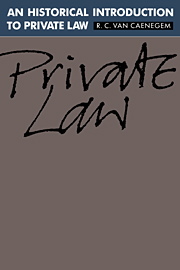Book contents
- Frontmatter
- Contents
- Preface to the English-language edition
- 1 The origins of contemporary private law, 1789–1807
- 2 Antecedents: the early Middle Ages, c. 500–c. 1100
- 3 Europe and Roman-Germanic law, c. 1100–c. 1750
- 4 Enlightenment, natural law and the modern codes: from the mid-eighteenth to the early nineteenth centuries
- 5 The nineteenth century: the interpretation of the Code civil and the struggle for the law
- 6 Statute, case law and scholarship
- 7 Factors
- General bibliography
- Index
Preface to the English-language edition
Published online by Cambridge University Press: 10 December 2009
- Frontmatter
- Contents
- Preface to the English-language edition
- 1 The origins of contemporary private law, 1789–1807
- 2 Antecedents: the early Middle Ages, c. 500–c. 1100
- 3 Europe and Roman-Germanic law, c. 1100–c. 1750
- 4 Enlightenment, natural law and the modern codes: from the mid-eighteenth to the early nineteenth centuries
- 5 The nineteenth century: the interpretation of the Code civil and the struggle for the law
- 6 Statute, case law and scholarship
- 7 Factors
- General bibliography
- Index
Summary
Private law is concerned with individual men and women whose relations, one hopes, will be harmonious; otherwise the courts intervene and settle their disputes peacefully and authoritatively. Since this extensive and pervading body of law regulates our daily lives, we may well pose the question as to how and when it was created. If we all happened to live under one and the same civil code, conceived and rapidly penned by Napoleon, the answer would be wonderfully simple. Legal history unfortunately is not that straight-forward: one complication is that the law of our present-day western world consists of two quite different systems, English Common Law and continental civil law, also called the law of the Roman-Germanic family. How these legal systems, both of European origin, came into being, went through various stages of development and always remained alien to each other is one of the themes of the present Introduction, where the continental lawyer may learn something about his own heritage but also about events across the Channel, and vice versa. At a time when British judges sit with their continental brethren in European courts of law, this may be especially welcome. National legal histories are readily available, and so are works on Roman and canon law – my Introduction is, of course, largely based on them – but studies that transcend national frontiers and attempt to weave the historic threads of common and civil law into one fabric are still rare. This may go some way towards justifying the present survey, which is the fruit of my teaching in the Law Faculties of the Universities of Ghent and – during the academic year 1984–85 – of Cambridge.
- Type
- Chapter
- Information
- An Historical Introduction to Private Law , pp. vii - viiiPublisher: Cambridge University PressPrint publication year: 1992



